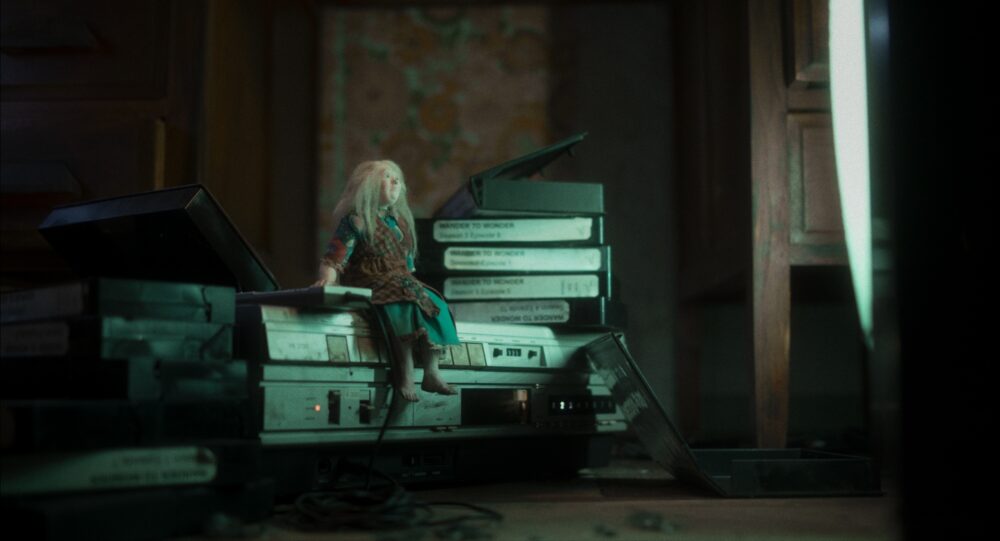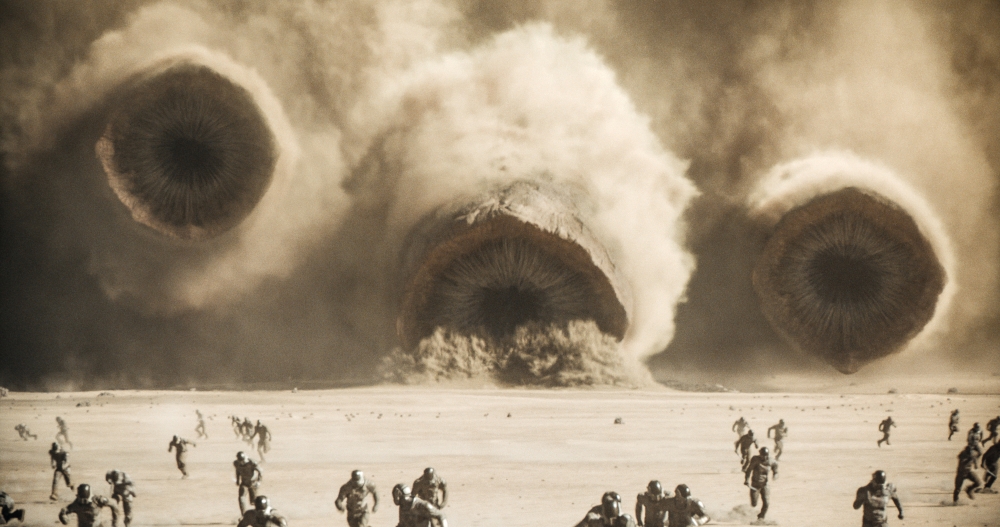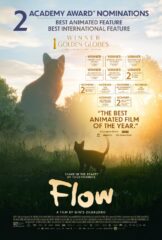Director Eric San‘s (a.k.a. Kid Koala) debut animated feature film Space Cadet is among the titles premiering at the 75th Berlin International Film Festival this week. The Canadian director, film composer and graphic novelist has released five solo albums, contributed to several feature film soundtracks including The Great Gatsby, Looper, Baby Driver and Scott Pilgrim vs. the World, has toured with the likes of Radiohead, Beastie Boys and The Preservation Hall Jazz Band and collaborated with Gorillaz, Deltron 3030 and Emilíana Torrini.
Space Cadet follows the relationship between Robot and a space-traveling scientist named Celeste. When Celeste leaves for her first interstellar mission, Robot feels terribly lonely, and his aging technical systems begin to wear out. We had the chance to speak with Kid Koala about his fascinating new animated journey:
Animation Magazine: Congrats on the debut of your imaginative new feature at the Berlin Intl Film Festival. Can you please share a bit about the film’s inspiration and beginnings?
![Eric San / Kid Koala [provided by subject]](https://www.animationmagazine.net/wordpress/wp-content/uploads/Kid-Koala-240x240.jpg)
Kid Koala: This film is based on my graphic novel, Space Cadet. It was a dialog-free story I had written about a guardian robot who raises a young child to become a great astronaut. The original book was inspired by a few events in my own life. I had written the book when I was in a bit of an introspective state as I was grieving the passing of my grandmother but also awaiting the arrival of my first daughter. This sent my thoughts back to the past, reminiscing about happy moments I spent with my parents and grandparents, but also thinking forward, about becoming a parent myself and what that would be like.
The screenplay for the film was written by Mylène Chollet. She poetically expanded the story of the original book to create a feature length film. I remember the day I read the very first draft of her screenplay and I was so moved by it I laughed out loud at moments (and I don’t usually laugh while I’m reading) and also shed some tears at the end. Her screenplay was poetic and emotionally dynamic. At that moment I knew we had to make this movie!
When did you start working on the project and how long did it take to make?
The film’s producer, Ginette Petit from Outsiders Films, first optioned the book from me around 14 years ago! And here we finally are on the brink of the world premiere at Berlinale Festival. It’s like a dream come true!
Which animation tools were used and where was the animation done?
Our head of story and production designer, Lillian Chan, did the first draft of storyboards on paper! We would tack them in sequence on these large cardboard 8×4 foot panels that lined the walls of the entire studio. We built the animatic in Premiere, timing the edits to music I had composed and recorded on piano and turntable. For the animation, we worked with a studio here in Montreal called Singing Frog. They animated the film using the Maya program.
![Space Cadet [Outsider Flms]](https://www.animationmagazine.net/wordpress/wp-content/uploads/Space-Cadet-1-1.jpg)
What do you love about working in animation?
I am a scratch DJ by trade. In scratching you are dealing with tiny slices of sounds. In animation you are dealing with tiny slices of movement. So there is a kinship between the two forms as far as attention to detail concerned.
Animation is sort of like that, the parameters of possibility are wider than in real life. It’s such a beautiful and expressive craft. You can easily defy gravity in animation, make bizarre situations or impossible architectural structures believable. I love that animation can live comfortably in the realm of the surreal. There is magic in each moment and I’m captivated by that.
What were the biggest challenges of the production for you?
When I was drawing the original graphic novel, I would work on the framing, layout, blocking, lighting and poses of the characters simultaneously while drawing each panel. Choices in all of those areas were kind of being made intuitively in real time.
This film project was done more in a traditional animation pipeline, so those steps were all done separately at different times in the production. I would work with the layout team for a few weeks, then move to animation for a few months, then lighting, then post, then sound mix etc.
I had to learn a few new languages in order to communicate with each department. I’m coming from music, film composing and live performance. I can intuitively talk about time in musical terms, beats, harmonies, frequencies, crescendos. But I learned that many of the animators understand time in “frames.” So instead of saying, “Robot should hold that pose for three quarter notes or until the chord change and the piano harmony starts,” I would say, “Please have robot hold that position for 60 frames.”
I was surprised to learn that the reverb level on the sound effects can completely change the humor in a scene. Or how the camera lensing and gamma levels can greatly affect the melancholy of the scene.
There are definitely a lot of moving parts in animation (pun intended), and the fun challenge was keeping the tone intact and making sure each scene was the strongest it could be, whether it was a comedic scene, a poignant moment or a suspenseful/action sequence.
![Space Cadet [Outsider Flms]](https://www.animationmagazine.net/wordpress/wp-content/uploads/Space-Cadet-2.jpg)
Can you tell us a bit about how you incorporated the music with the narrative?
When I was six or seven years old, I remember watching Charlie Chaplin’s Modern Times with all generations of my family. My sister, parents and grandmother all huddled around the TV enjoying the same film. I’d never heard my grandmother laugh at the television so much. It’s one of my favorite memories from childhood. I knew back then when I grew up I wanted to create a similar feeling with audiences someday.
So in that tradition, this film is dialog-free. The music is the emotional engine of the film. Over the years, I’ve been writing dialog-free graphic novels and touring theatrical puppetry/string quartet/turntable productions like Nufonia Must Fall and The Storyville Mosquito (also without dialog) around the world. I’ve learned that dialog-free narratives are one of my favorite ways to tell a story. It becomes interactive for the audience in a slightly different way, like a little puzzle where the audience may need to delve into their own experiences to predict what the character is thinking or feeling.
I composed and recorded sketches of most of the score originally on piano and turntable, and placed them into the scenes so that the animators had a timing/tempo guideline for tone and mood. For a handful of the scenes, I invited some of my favorite singers to contribute the score. There are some original songs from Karen O and Mariana (Ladybug) Vieira from Digable Planets. There are also renditions of some classic tunes from yesteryear featuring Emilíana Torrini, Martha Wainwright and some brand new songs I wrote for Meaghan Smith and Trixie Whitley. Each of them have such a distinct sound and style and bring so much feeling to those songs and scenes. It was a dream to have all these people contribute musically to the film.
Once the animation was done, I worked with my longtime collaborator Vid Cousins to complete the orchestrations. We went to various studios to record live strings and brass. And I would continue to add other instrument layers in my studio including guitar, percussion and synthesizers for the space scenes. For some of the flashback moments in the film, I would cut the live instrument recordings onto vinyl using my record cutter and re-track it back into the tune to add that dust and record crackle for a more surreal, nostalgic tone to the music.
What do you hope audiences will take away from the world of Space Cadet?
Quite simply, my intention was to try and put something fun and beautiful into the world. It’s a story about shared moments, connection, the cycles of generations and the bonds that connect us. So I hope people will watch it with those close to them. I hope they laugh and cry and enjoy the adventure. But most of all, I hope the underlying themes of time and shared moments will resonate with them and their own experiences and memories somehow.
![Space Cadet [Outsider Flms]](https://www.animationmagazine.net/wordpress/wp-content/uploads/Space-Cadet-3.jpg)
Who are your big animation heroes and influences?
My earliest memory of seeing animation would be from watching those playful and trippy animated shorts on Sesame Street. That Pinball Number song with the 2D animation and the Pointer Sisters singing was the raddest. That is still one of the funkiest tracks and videos to ever be on heavy rotation on TV!
I’m a huge fan of Aardman, Mark Osborne, Brad Bird, Domee Shi, Chris Sanders, Nora Twomey, Shannon Tindle, Jorge Gutierrez, Miyazaki, the list goes on and on!
I love the surreal style of Monkmus’ animation and was able to work with him on a few music videos for my early album releases.
There’s a stop-motion team here in Montreal called See Creature who are amazing. I always love going to their studio to see what they’re cooking up.
Lillian Chan, who I brought on to be the head of story/production designer on Space Cadet is one of my favorite artists on the planet. Everything she does is so beautiful and nuanced. I knew Lillian and art director Corinne Merrell were the perfect team to design the look of this film.
I have to mention Jonathan Ng a.k.a. Jon Jon Animation; we got to work on a 2D hand-drawn animated breakdance battle video game called Floor Kids. He’s a b-boy himself and probably one of the only dudes crazy enough to draw 10,000-plus frames per character in the game engine and link them through unique animation branches so it would be dance/gravity/torque accurate. I brought him on the project to storyboard all the action fight and flight sequences in the film.
Most recently I got to work on some music with Clyde Henry Studios for one of their projects in their stop-motion lab.
Really, I’m in awe of all my animator friends. They are all such thoughtful and visionary people. I’m truly inspired by the dedication they each have to their craft and the magic that they make happen on the screen one frame at a time.
Space Cadet is making its World Premiere at Berlinale. Find showtimes here. Paris-based Urban Sales is handling worldwide sales for the film. Learn more at outsiderfilms.com.
![Space Cadet [Outsider Flms]](https://www.animationmagazine.net/wordpress/wp-content/uploads/Space-Cadet-4.jpg)





![Wallace and Gromit_Vengeance Most Fowl_PS_030_01500_Norbot_Unboxing Wallace & Gromit: Vengeance Most Fowl [Aardman/Netflix]](https://www.animationmagazine.net/wordpress/wp-content/uploads/Wallace-and-Gromit_Vengeance-Most-Fowl_PS_030_01500_Norbot_Unboxing-696x391.jpg)




![Space Cadet 5 Space Cadet [Outsider Flms]](https://www.animationmagazine.net/wordpress/wp-content/uploads/Space-Cadet-5-696x400.jpg)
![Eric San / Kid Koala [provided by subject]](https://www.animationmagazine.net/wordpress/wp-content/uploads/Kid-Koala-240x240.jpg)
![Space Cadet [Outsider Flms]](https://www.animationmagazine.net/wordpress/wp-content/uploads/Space-Cadet-1-1.jpg)
![Space Cadet [Outsider Flms]](https://www.animationmagazine.net/wordpress/wp-content/uploads/Space-Cadet-2.jpg)
![Space Cadet [Outsider Flms]](https://www.animationmagazine.net/wordpress/wp-content/uploads/Space-Cadet-3.jpg)
![Space Cadet [Outsider Flms]](https://www.animationmagazine.net/wordpress/wp-content/uploads/Space-Cadet-4.jpg)

![Miss Moxy_North_Studio 100 Miss Moxy | North [c/o Studio 100 Film]](https://www.animationmagazine.net/wordpress/wp-content/uploads/Miss-Moxy_North_Studio-100-696x418.jpg)


![FLOW_Still9 - Courtesy of Sideshow and Janus Films Flow [c/o Sideshow and Janus Films]](https://www.animationmagazine.net/wordpress/wp-content/uploads/FLOW_Still9-Courtesy-of-Sideshow-and-Janus-Films-696x345.jpg)


![Jerry Eisenberg obit collage Jerry Eisenberg [ph. c/o The Animation Guild]](https://www.animationmagazine.net/wordpress/wp-content/uploads/Jerry-Eisenberg-obit-collage-696x418.jpg)





![FLOW_Still5-Courtesy-of-Sideshow-and-Janus-Films Flow [c/o Sideshow and Janus Films]](https://www.animationmagazine.net/wordpress/wp-content/uploads/FLOW_Still5-Courtesy-of-Sideshow-and-Janus-Films-696x345.jpg)

![Burps Butts and Bones featured Burps, Butts and Bones [c/o Sphere Media]](https://www.animationmagazine.net/wordpress/wp-content/uploads/Burps-Butts-and-Bones-featured-696x418.png)







![Lil Kev new cast Lil Kev additional cast [c/o BET+]](https://www.animationmagazine.net/wordpress/wp-content/uploads/Lil-Kev-new-cast-696x392.jpg)

![Natalia Leon [provided by subject]](https://www.animationmagazine.net/wordpress/wp-content/uploads/Natalia_Leon-240x240.jpg)




